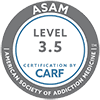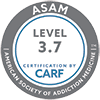What is Trauma and How does it impact addiction?
According to the American Psychological Association, trauma is “an emotional response to a terrible event like an accident, rape or natural disaster.” Typically, initial reactions of shock and grief abate over time. But some people have longer-term reactions to the experience and can become prone to “unpredictable emotions, flashbacks, strained relationships and even physical symptoms like headaches or nausea.”
Trauma can be experienced on any level: mental, psychological, emotional, and physical. Many people who experience trauma do not develop an addiction, but research clearly indicates a connection between addiction and trauma. Many individuals develop not only drug and/or alcohol addiction, but also eating disorders and compulsive sexual behavior to escape the pain of trauma.
Up to 34% of individuals in substance use disorder treatment have a dual-diagnosis of addiction and PTSD.
Trauma can occur to anyone, at any age, regardless of gender, race, or socioeconomic factors. Recognition of trauma as a root cause of addiction is not new. Addiction treatment professionals have long understood the role of trauma in the development of substance abuse disorders and relapse.
These statistics are from a report issued by the National Center for Post-Traumatic Stress Disorder and the Department of Veterans Affairs:
- A diagnosis of PTSD increases the risk of developing alcohol and/or drug abuse.
- Ten to thirty-three percent of survivors of accidents, illnesses, or natural disasters report alcohol abuse.
- Both male and female sexual abuse survivors experience a higher rate of drug and/or alcohol abuse compared to those who have not experienced sexual abuse.
- Sources estimate that up to 75% of people who survive abuse and/or violent trauma develop substance abuse problems.
These studies show that when someone has experienced a traumatic event, they often seek out relief from the pain. Addiction to food, drugs, sex, gambling, etc., becomes a coping mechanism. Due to advances in science, we can now understand why.
The amygdala is the part of the brain that detects threat. In the case of trauma, the amygdala becomes overactive, constantly seeing and assessing what it interprets as threat. At the same the time, the hippocampus (where the brain processes memories) becomes underactive, resulting in old memories getting stuck in a present-day loop. In essence, your brain behaves as if the traumatic event you experienced is continually happening. With the brain in constant survival mode, your capacity to think logically and monitor your behavior is decreased. This makes it even harder to overcome addiction.
Addiction is the desire to feel better, and trauma is often a root cause.
Sadly, most traumatic events that are likely to lead to addictive behaviors occur during childhood, or at a young age. The Adverse Childhood Experience study was based on data from over 17,000 patients. The study found direct correlation between severe childhood stress (neglect, abuse, domestic violence, having a mentally ill or substance abusing parent) and various types of addictions. The results were clear. A child with four or more adverse experiences is five times more likely to become addicted to alcohol, 60% more likely to be obese, and 46 times more likely to become an injection user than children who did not have adverse experiences. The research found that the effects of trauma are cumulative.
The first step in recovering from addiction is getting to the root causes, and many individuals have to dig into their childhood to discover where it all began.
Instead of feeling shame, guilt, and remorse for an addiction, a person who has suffered trauma can recognize that their addiction is a way to cope with painful feelings. Once this is understood, and the person has gone through detox, they can then begin to deal with the underlying cause. Most people suffering from trauma will benefit from individual and group therapy to work through the emotions and feelings attached to the trauma.




